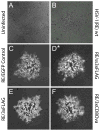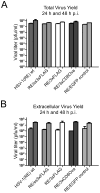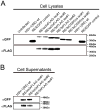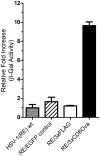Efficient generation and rapid isolation via stoplight recombination of Herpes simplex viruses expressing model antigenic and immunological epitopes
- PMID: 22036596
- PMCID: PMC3249488
- DOI: 10.1016/j.jviromet.2011.10.009
Efficient generation and rapid isolation via stoplight recombination of Herpes simplex viruses expressing model antigenic and immunological epitopes
Abstract
Generation and isolation of recombinant herpesviruses by traditional homologous recombination methods can be a tedious, time-consuming process. Therefore, a novel stoplight recombination selection method was developed that facilitated rapid identification and purification of recombinant viruses expressing fusions of immunological epitopes with EGFP. This "traffic-light" approach provided a visual indication of the presence and purity of recombinant HSV-1 isolates by producing three identifying signals: (1) red fluorescence indicates non-recombinant viruses that should be avoided; (2) yellow fluorescence indicates cells co-infected with non-recombinant and recombinant viruses that are chosen with caution; (3) green fluorescence indicates pure recombinant isolates and to proceed with preparation of viral stocks. Adaptability of this system was demonstrated by creating three recombinant viruses that expressed model immunological epitopes. Diagnostic PCR established that the fluorescent stoplight indicators were effective at differentiating between the presence of background virus contamination and pure recombinant viruses specifying immunological epitopes. This enabled isolation of pure recombinant viral stocks that exhibited wildtype-like viral replication and cell-to-cell spread following three rounds of plaque purification. Expression of specific immunological epitopes was confirmed by western analysis, and the utility of these viruses for examining host immune responses to HSV-1 was determined by a functional T cell assay.
Copyright © 2011 Elsevier B.V. All rights reserved.
Figures








Similar articles
-
Fast and efficient generation of recombinant baculoviruses by in vitro transposition.Appl Microbiol Biotechnol. 2012 Dec;96(5):1353-60. doi: 10.1007/s00253-012-4468-3. Epub 2012 Oct 11. Appl Microbiol Biotechnol. 2012. PMID: 23053112
-
Mechanism of neutralization of herpes simplex virus by antibodies directed at the fusion domain of glycoprotein B.J Virol. 2014 Mar;88(5):2677-89. doi: 10.1128/JVI.03200-13. Epub 2013 Dec 18. J Virol. 2014. PMID: 24352457 Free PMC article.
-
Replication-competent herpes simplex virus type 1 mutant expressing an autofluorescent glycoprotein H fusion protein.Intervirology. 2001;44(4):232-42. doi: 10.1159/000050053. Intervirology. 2001. PMID: 11509886
-
Development and pathogenic evaluation of recombinant herpes simplex virus type 1 expressing two fluorescent reporter genes from different lytic promoters.Virology. 2008 Sep 1;378(2):254-64. doi: 10.1016/j.virol.2008.05.034. Epub 2008 Jul 11. Virology. 2008. PMID: 18619637 Free PMC article.
-
Recombination promoted by DNA viruses: phage λ to herpes simplex virus.Annu Rev Microbiol. 2014;68:237-58. doi: 10.1146/annurev-micro-091313-103424. Epub 2014 Jun 9. Annu Rev Microbiol. 2014. PMID: 25002096 Free PMC article. Review.
Cited by
-
Development and evaluation of a host-targeted antiviral that abrogates herpes simplex virus replication through modulation of arginine-associated metabolic pathways.Antiviral Res. 2016 Aug;132:13-25. doi: 10.1016/j.antiviral.2016.05.009. Epub 2016 May 15. Antiviral Res. 2016. PMID: 27192555 Free PMC article.
-
Development and evaluation of SYBR Green-I based quantitative PCR assays for herpes simplex virus type 1 whole transcriptome analysis.J Virol Methods. 2014 Jun;201:101-11. doi: 10.1016/j.jviromet.2014.02.010. Epub 2014 Mar 4. J Virol Methods. 2014. PMID: 24607486 Free PMC article.
-
HSV-2 inhibits type-I interferon signaling via multiple complementary and compensatory STAT2-associated mechanisms.Virus Res. 2012 Aug;167(2):273-84. doi: 10.1016/j.virusres.2012.05.010. Epub 2012 May 23. Virus Res. 2012. PMID: 22634037 Free PMC article.
-
Herpes Simplex Virus-1 Induced Serotonin-Associated Metabolic Pathways Correlate With Severity of Virus- and Inflammation-Associated Ocular Disease.Front Microbiol. 2022 Mar 22;13:859866. doi: 10.3389/fmicb.2022.859866. eCollection 2022. Front Microbiol. 2022. PMID: 35391733 Free PMC article.
References
-
- Barnden MJ, Allison J, Heath WR, Carbone FR. Defective TCR expression in transgenic mice constructed using cDNA-based alpha- and beta-chain genes under the control of heterologous regulatory elements. Immunol Cell Biol. 1998;76:34–40. - PubMed
-
- Bhattacharjee PS, Neumann DM, Foster TP, Clement C, Singh G, Thompson HW, Kaufman HE, Hill JM. Effective treatment of ocular HSK with a human apolipoprotein E mimetic peptide in a mouse eye model. Invest Ophthalmol Vis Sci. 2008;49:4263–8. - PubMed
-
- Brandt CR, Kolb AW, Shah DD, Pumfery AM, Kintner RL, Jaehnig E, Van Gompel JJ. Multiple determinants contribute to the virulence of HSV ocular and CNS infection and identification of serine 34 of the US1 gene as an ocular disease determinant. Invest Ophthalmol Vis Sci. 2003;44:2657–68. - PubMed
-
- Brandt CR. The role of viral and host genes in corneal infection with herpes simplex virus type 1. Exp Eye Res. 2005;80:607–21. - PubMed
-
- Cantin E, Chen J, Willey DE, Taylor JL, O’Brien WJ. Persistence of herpes simplex virus DNA in rabbit corneal cells. Invest Ophthalmol Vis Sci. 1992;33:2470–5. - PubMed
Publication types
MeSH terms
Substances
Grants and funding
LinkOut - more resources
Full Text Sources

